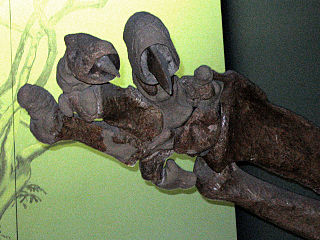Megatheriidae
Extinct family of ground sloths From Wikipedia, the free encyclopedia
Megatheriidae is a family of extinct ground sloths that lived from approximately 23 mya—11,000 years ago.[3]
| Megatheriidae | |
|---|---|
 | |
| Eremotherium skeleton, NMNH, Washington, DC. | |
| Scientific classification | |
| Domain: | Eukaryota |
| Kingdom: | Animalia |
| Phylum: | Chordata |
| Class: | Mammalia |
| Order: | Pilosa |
| Superfamily: | Megatherioidea |
| Clade: | †Megatheria |
| Family: | †Megatheriidae J. E. Gray 1821 |
| Type genus | |
| †Megatherium americanum | |
| Subgroups | |
| |


Megatheriids appeared during the Late Oligocene (Deseadan in the SALMA classification), some 29 million years ago, in South America. The group includes the largest known ground sloths, the elephant sized Megatherium (given its name 'great beast' by Georges Cuvier[4]) and Eremotherium. An early genus that was originally considered a megatheriid, the more slightly built Hapalops, reached a length of about 1.2 metres (3.9 ft). The nothrotheres have recently been placed in their own family, Nothrotheriidae.[5]
The skeletal structure of these ground sloths indicates that the animals were massive. Their thick bones and even thicker joints (especially those on the hind legs) gave their appendages tremendous power that, combined with their size and fearsome claws, provided a formidable defense against predators.
The earliest megatheriid in North America was Sibotherium which arrived 5.3 million years ago, after crossing the recently formed Panamanian land bridge. At more than five tons in weight, 6 metres (20 ft) in length, and able to reach as high as 5.2 metres (17 ft), Eremotherium when fully erect was taller than an African bush elephant bull. Unlike relatives, this species retained a plesiomorphic extra claw. While other species of Eremotherium had four fingers with only two or three claws, E. eomigrans had five fingers, four of them with claws up to nearly 30 centimetres (1 ft) long.[6]
Phylogeny
Summarize
Perspective
The following sloth family phylogenetic tree is based on collagen and mitochondrial DNA sequence data (see Fig. 4 of Presslee et al., 2019).[7]
| Folivora |
| |||||||||||||||||||||||||||
The following phylogeny is based on Varela et al. 2019.[8]
| Folivora |
| ||||||||||||||||||||||||||||||||||||||||||||||||||||||||||||||||||||||||||||||||||||||||||||||||||||||||||||||||||||||||||||||||||||||||||||||||||||||||||||||||||||||||||||||||||||||||||||||||||||||||||||||||||||||||||||||||||||||||||
References
External links
Wikiwand - on
Seamless Wikipedia browsing. On steroids.
